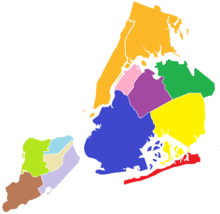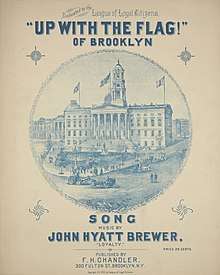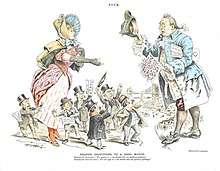City of Greater New York
The City of Greater New York was the term used by many politicians and scholars for the expanded City of New York created on January 1, 1898, by consolidating the existing City of New York with Brooklyn, western Queens County, and Staten Island.[1][2] The section of the Bronx west of the Bronx River had been annexed to the City and County of New York in 1874 and was known as the Annexed District.[3][4] The section of the Bronx east of the Bronx River had been annexed to New York City, and New York County, in 1895.

New York County:
In the years leading up to consolidation, the City of Brooklyn had expanded by annexing all of the other towns and cities in Kings County. Only the western part of Queens County was part of the consolidation plan.[5] In 1899, its three eastern towns separated to form the new Nassau County.[6]
Background
New York City had been founded in the 1620s by the Dutch as New Amsterdam at the southern tip of the island of Manhattan. The English conquered the territory and established the original twelve counties of the Province of New York in 1683; one of these was the City and County of New York. A 1691 law defined New York City to be the entirety of Manhattan, while Manning's Island (now Roosevelt Island), the Barn Islands (now Randalls and Wards Islands), and the Oyster Islands (now Ellis Island) were New York County.[7] Towns had been established in the rest of the province by 1691, and were reincorporated after the American Revolution in 1788.[8]
Brooklyn had been chartered by the Dutch in 1646; the Town of Brooklyn was one of the towns incorporated by 1691[7] and reestablished in 1788.[9] It was located within Kings County,[7] another county established by the English in 1683. It was incorporated as a village in 1814 and as a city in 1834. Originally comprising what is now Downtown Brooklyn, it would annex its surroundings through the 19th century and grow to encompass all of Kings County in 1895. By the 1890 United States Census it had become the fourth-largest city in the United States.
Since the late 1820s there had been some discussion of a unified city, with the New York State legislature voting in 1857 that the region surrounding New York City should become one more efficient body.[10] They attempted to do so by government vote, in order to improve harbor facilities and link the systems of trade, but distrust of large projects killed the plans.[11]
Consolidation
The consolidation movement was the work of politicians both local, city, and state, most prominently the president of the "Greater New-York Commission"[12] and "The Father of Greater New York"[13] Andrew Haswell Green. He was a member of the Board of Commissioners of Central Park, which provided him a platform to push his views.[14]

The next challenge to the independence of the boroughs was a self-promoted and government-appointed commission. The commission led the “Vote for Greater New York" movement and was the force behind it coming to fruition.[12] Some opponents derided the effort as "Andy Green's hobby," but eventually they were proven wrong.[15] The center of the plan was the consolidation of the twin cities of New York and Brooklyn, whose fire departments had been merged into a Metropolitan Fire District in 1865.[16] The addition of Long Island City and various rural areas anticipated future development of those areas. With Republicans historically more powerful in Brooklyn and Democrats elsewhere, partisan politics played a role, each major political party hoping to dominate the consolidated city.

The plan required a referendum in all affected areas, though the organizers of the referendum clearly had a bias towards the consolidation. They even released a full page advertisement in The New York Times before the vote took place, urging them to vote "For Consolidation".[12] An argument for consolidation was that the unconsolidated city would soon be surpassed by Chicago as the most populous city in the United States.[5]
Opposition, concentrated in Brooklyn and other outlying districts, focused on loss of local control and fears of ethnic and racial minorities. Independence-minded Brooklynites did not want their regional identity to be overtaken by New York.[17] Some newspapers such as the Brooklyn Daily Eagle argued that consolidation would destroy the mostly homogenous, Protestant character of the city.[3] Opposing newspapers were accused of seeking to retain the revenues of official advertising, while opposing politicians were accused of graft. Concerns over how Brooklyn's water supply would be maintained and how future financial backing would be possible were legitimate.[18] Considerations of finance and water supply prevailed, and the people of Brooklyn voted by a narrow margin to consolidate.[19][20][21]
The term City of Greater New York was never a legal or official designation as both the original charter of 1898 and the newer one of 1938 use the name of City of New York.[3] It is still used in modern-day books relating or including the time period when the consolidation took place.[22]
While remaining a county in relation to the state, each county became a borough within the city, with the Bronx reunited to form a fifth borough that shared New York County with Manhattan. A separate Bronx County was established in 1914, making the present New York County co-extensive with the Borough (but not the island) of Manhattan.
Subsequent history
Since the enlarged city contained the majority of the state of New York's population, and the enlargement increased the city's already enormous power within the state, the state legislature established certain oversight powers within the city. For example, some issues of taxation and changes in governmental procedures require state approval or granting of specific home rule powers.
Conversely, the State Constitution was amended to provide that no city could elect the majority of the State Assembly, a provision later struck down by the U.S. Supreme Court as violating the Fourteenth Amendment to the United States Constitution. The New York City Board of Estimate, created in the consolidation charter with equal votes for each borough, was struck down on similar grounds in 1989.
Staten Island secession
Staten Island is geographically the most distant of the five boroughs, linked to the other four only by a single bridge and a ferry. In 1993 it held a non-binding referendum on the issue of seceding from New York City to become an independent city and county.[23] Ultimately, 65% of Staten island residents voted to secede, through the approval of a new city charter making Staten Island an independent city, but implementation was blocked in the State Assembly.[24][25] The Staten Island secession movement was defused by the election of Rudy Giuliani as New York City mayor, who fulfilled two of the borough's biggest demands: the closing of the Fresh Kills Landfill and making the Staten Island Ferry free.[lower-alpha 1]
See also
- List of former municipalities in New York City
- Boroughs of New York City
- History of New York City (1855–97)
- History of New York City (1898–1945)
References
Citations
- "Of Interest To Politicians". The New York Times. September 13, 1894. p. 9. Retrieved April 19, 2013.
- "Greater New-York In Doubt; The City Vote Is For It And Brooklyn Is Uncertain". The New York Times. November 8, 1894. Retrieved April 19, 2013.
- Jackson, Kenneth T. (1995). Encyclopedia of the City of New York. New Haven & New York: Yale University Press. ISBN 0300182570.
- "The East City Line Fixed". The New York Times. February 12, 1899. p. 15. Retrieved December 28, 2007.
- "New-York's Place In Danger; Consolidation Defeated, She Must Yield To Chicago". The New York Times. November 4, 1894. Retrieved April 19, 2013.
- Geoffrey Mohan (Staff Writer) (2007). "Nassau's Difficult Birth; Eastern factions of Queens win the fight to separate after six decades of wrangling". Newsday. Archived from the original on October 16, 2008. Retrieved April 19, 2013.
North Hempstead, Oyster Bay and the rest of Hempstead were excluded from the vote.
- "An Act to divide the Province and Dependencies, into Shires and Counties, Pass'd the 1st of October, 1691". Laws of New-York, From The Year 1691, to 1751, inclusive. New York: James Parker. 1752. p. 7. Retrieved March 18, 2020 – via HeinOnline.
- "AN ACT for dividing the counties of this State into towns, Passed the 7th of March, 1788". Laws of the State of New York passed at the sessions of the legislature held in the years 1785, 1786, 1787 and 1788, inclusive, being the eighth, ninth, tenth and eleventh sessions. Albany, New York: Weed Parsons and Company. 1886. pp. 748–762.
- "Kings County: Brooklyn". Laws of the State of New York passed at the sessions of the legislature held in the years 1785, 1786, 1787 and 1788, inclusive, being the eighth, ninth, tenth and eleventh sessions. Albany, New York: Weed Parsons and Company. 1886. p. 749.
- Kessner, Capital City, p.319
- Kessner, Capital City p.60
- "Vote For Greater New-York; Commissioners Offer Arguments For A Mighty City". October 16, 1894. Retrieved May 15, 2016.
- Haberman, Clyde (May 14, 2004). "NYC; A.H. Green? You could sit on It". New York Times. Retrieved May 15, 2016.
- Kessner, Capital City, pp.62-67
- Kessner, Capital City, p.63
- "History of Fire Service". Archived from the original on December 21, 2007. Retrieved February 21, 2012.
- Samantha Sokol, "1898 Consolidation of NYC," Untappedcityies.com, http://untappedcities.com/tag/1898-consolidation-of-nyc/
- Kroessler, Jeffrey A. (2011). "Brooklyn's Thirst, Long Island's Water: Consolidation, Local Control, and the Aquifer". Long Island History Journal. 22 (1). ISSN 0898-7084.
- Edwin G. Burrows and Mike Wallace, Gotham: A History of New York City to 1898 (The History of New York City)
- "Vote for Greater New York". The New York Times. October 16, 1894. Retrieved December 28, 2007.
- "Official Announcement of the Results of the Election" (PDF). The New York Times. December 15, 1894. Retrieved December 28, 2007.
The area included a radius of twenty miles, with the city hall in New York as a center to circumscribe it
- Kessner, Thomas (2004). Capital City: New York City and the Men Behind America's Rise to Dominance 1860-1900. New York City: Simon & Schuster. pp. 60, ibid. ISBN 978-0743257534.
- Article about Staten Island Secession Archived September 27, 2006, at the Wayback Machine at the City Journal web site
- McFadden, Robert D. (March 5, 1994). "'Home Rule' Factor May Block S.I. Secession". The New York Times. Retrieved October 20, 2009.
- Kashiwagi, Sydney (November 8, 2019). "Forgotten borough no more: Borelli moves forward with plan to revive Island secession from New York City". silive. Retrieved November 11, 2019.
- Sontag, Deborah (July 5, 1997). "On the Staten Island Ferry, Illusory 'Free Ride' Is Reality". The New York Times. ISSN 0362-4331. Retrieved September 19, 2017.
- "Fresh Kills". New York City Department of City Planning. 2009. Archived from the original on November 24, 2009. Retrieved October 20, 2009.
Further reading
- "Inventing Gotham". Archived from the original on July 23, 2011. Retrieved December 28, 2007.
- Holice, Deb & Pam. "The History of New York State". Archived from the original on August 22, 2007. Retrieved December 28, 2007.
- Dr. James Sullivan (editor). The History of New York State. Book II, Chapter IV Part VIII.CS1 maint: extra text: authors list (link)